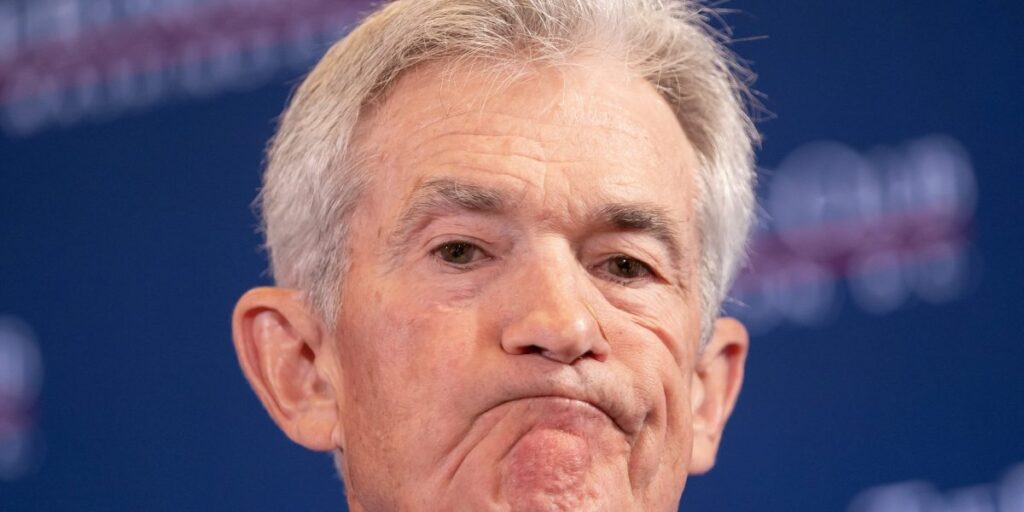It’s been exactly a year since the Fed’s last rate hike, and these parts of the economy are finally feeling the squeeze
“Things have softened in the last couple months, and Fed officials are going to be pretty concerned if they start softening more rapidly.”


In the year since the Federal Reserve brought interest rates to a more than two-decade high, the central bank has succeeded in taking the steam off of an overheated US economy. But higher borrowing costs have also had some unexpected effects.
Higher-income households are reaping the benefits of a booming stock market and rising home values. Corporations are borrowing at a fast clip, and consumers continue to spend.
But in other ways, a year of high interest rates is finally beginning to take a toll. Americans are searching longer for jobs, and the unemployment rate has inched higher. Small businesses are feeling the pain from costlier loans. And lower-income households are falling behind on payments for their car loans and credit cards.
“Things have softened in the last couple months, and Fed officials are going to be pretty concerned if they start softening more rapidly,” said Veronica Clark, an economist at Citigroup Inc, adding that would lead officials to cut rates more rapidly.
Policymakers are widely expected to keep interest rates steady when they meet next week, but investors anticipate the Fed will begin lowering borrowing costs in September. Until then, evaluating how Fed policy is — and isn’t — impacting the economy will help guide officials seeking to tame inflation without wrecking the jobs market.
Housing Market
Rate hikes had the clearest impact on the US housing market, where Fed policy not only spurred a surge in borrowing costs but also a run-up in home prices. A measure of home affordability is near its lowest level in more than three decades of data.
With mortgage rates hovering around 7%, the monthly mortgage payment for someone buying a median priced home climbed to $2,291 in May, up from $1,205 three years earlier, according to the National Association of Realtors.
Economists expected sales to decline in response to the higher borrowing costs — and they did. “What was unexpected is how powerful the lock-in effect can be if the economy is not in a recession,” said Ralph McLaughlin, senior economist for Realtor.com.
Existing homeowners, who secured ultra-low mortgage rates during the pandemic, are still reluctant to put their properties on the market. That made a limited supply of homes even more limited and pushed housing prices to new heights.
Stock Boom
Higher interest rates typically serve as an anchor on stocks by slowing business investment and growth. But investors have largely shrugged off those concerns, allowing equity prices — and Americans’ retirement accounts — to surge to new levels.
The S&P 500 has climbed about 25% since the Fed started raising rates in March 2022, adding about $3 trillion to household wealth.
If the Fed doesn’t start lowering rates soon, however, “the market’s going to be vulnerable,” said Mark Zandi, chief economist for Moody’s Analytics. It’s “embedded in current stock prices that investors expect rate cuts.”
Job Market
The US jobs market, which bucked expectations of a slowdown time and again despite high rates, is finally showing signs of cooling.
Hiring has slowed from the overheated levels seen two years ago, and companies are posting fewer job openings. Employed Americans are quitting less, and those out of work are finding it harder to land a job.
The number of people who have been out of work for 27 weeks or more, known as long-term unemployed, rose to 1.5 million in June, the most since 2017 with the exception of a temporary spike during the pandemic, said Aaron Terrazas, chief economist for Glassdoor.
Hiring has become more concentrated to just a few sectors — like healthcare, social assistance and government — a sign that other industries more vulnerable to economic slowdowns are starting to pull back, he said.
Taken together, the figures raise concerns that the job market could weaken unexpectedly, a turn that would put the overall economy at risk. Fresh data on the state of the labor market will be published Friday.
Consumer Resilience
Consumers have continued to spend and make major purchases such as cars despite high loan rates, fueling solid economic growth. The resilience of spending is one of the key reasons economists are hopeful the Fed can tame inflation without sparking a recession.
Some have even argued high rates themselves are helping to support that spending, with wealthier households and retirees seeing a stream of income from their bond investments and savings accounts. But many households, particularly those with lower incomes who turned to credit to keep up with rising living expenses, are feeling the squeeze of elevated borrowing costs.
Interest rates for credit cards rose to 22.76% in May, just shy of a record in data back to 1994, Fed data show. Some 2.6% of credit card balances were 60 days past due in the first quarter, reaching a series high in data from the Philadelphia Fed that goes back to 2012.
Spending from low-income households only accounts for 15% of overall consumer spending, but the economy cannot thrive if that group is struggling, said Zandi.
Business Borrowing
High interest rates haven’t stopped large corporations from borrowing as much as they ever have. Firms are taking advantage of robust demand from long-term investors, such as pension funds and insurance companies, that are seeking to lock-in some higher payouts before the Fed cuts.
Plus, the longer term bonds they issue have fixed rates and about 10 years of maturity, meaning they are not as directly affected by what the Fed does, said Hans Mikkelsen, managing director of credit strategy at TD Securities.
The picture is much different for smaller businesses. The default rate on leveraged loans, which typically have variable rates, is projected to rise to a range of 5% to 5.5% this year, according to forecasts from Fitch Ratings. If realized, that would be the highest level since 2009.
“There’s a tremendous amount of pain and many, many companies that are going bust because of the Fed’s monetary policy,” Mikkelsen said.





